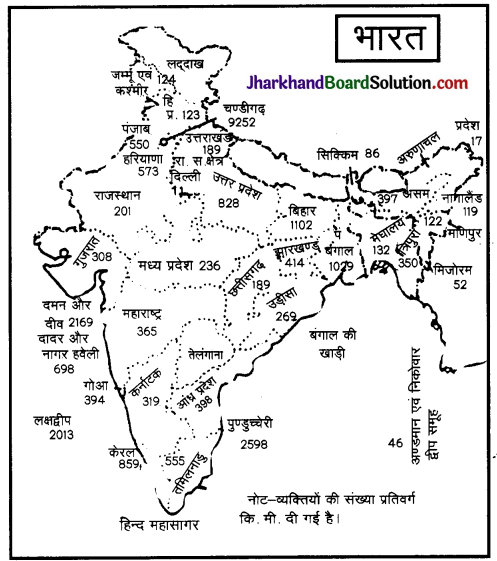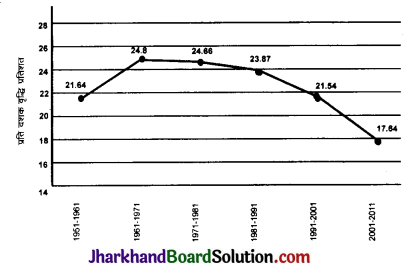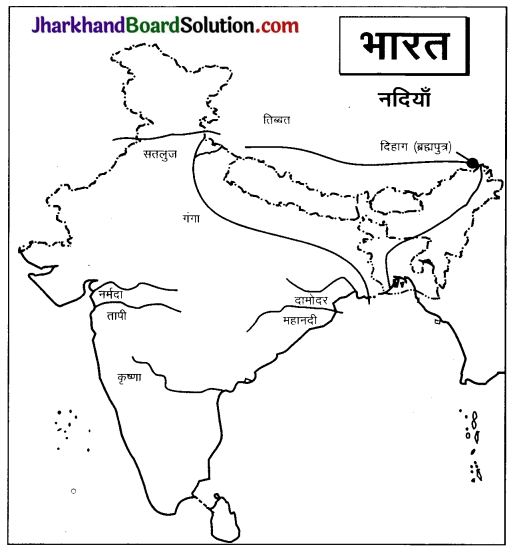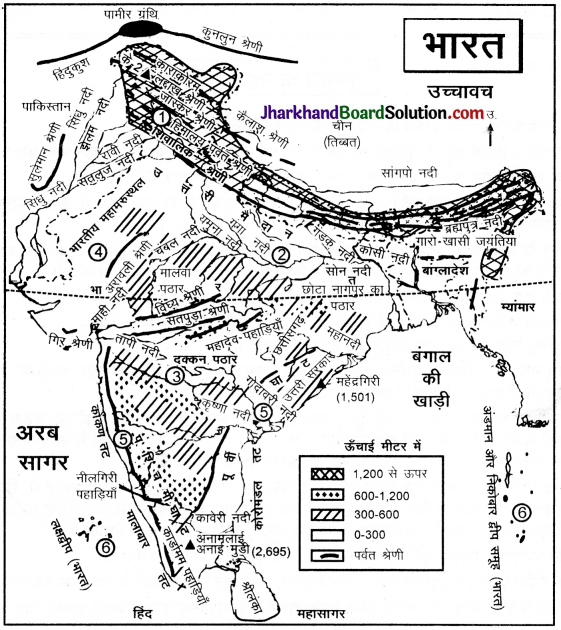JAC Board Class 9th Social Science Important Questions Geography Chapter 5 प्राकृतिक वनस्पति एवं वन्य जीवन
वस्तुनिष्ठ प्रश्न
प्रश्न 1.
(i) अर्जुन का सम्बन्ध किस प्रकार की वनस्पति से है
(क) पर्णपाती वन
(ख) उष्ण कटिबन्धीय वर्षा वन
(ग) मैंग्रोव
(घ) कंटीले वन।
उत्तर:
(क) पर्णपाती वन।
(ii) नंदादेवी जीवमण्डल निचय कौन से राज्य में स्थित है
(क) पंजाब
(ख) उत्तराखण्ड
(ग) उड़ीसा
(घ) कर्नाटक।
उत्तर:
(ख) उत्तराखण्ड।
(iii) आबनूस के वृक्ष कितनी वर्षा वाले क्षेत्र में पाये जाते हैं
(क) 200 सेमी.
(ख) 100 सेमी.
(ग) 70 सेमी.
(घ) 20 सेमी.।
उत्तर:
(क) 200 सेमी.।
(iv) कौन-सा पादप खाँसी और जुकाम की दवा के रूप में प्रयोग किया जाता है?
(क) कचनार
(ख) तुलसी
(ग) बबूल
(घ) जामुन।
उत्तर:
(ख) तुलसी।
(v) भारतीय शेरों का प्राकृतिक वास स्थल है
(क) गिर वन
(ख) नन्दादेवी
(ग) सिमलीपाल
(घ) सुन्दर वन।
उत्तर:
(क) गिर वन।
(vi) विश्व के जीवमंडल निचय में सम्मिलित भारतीय जीवमंडल हैं
(क) सुन्दर वन
(ख) मन्नार की खाड़ी
(ग) कंचनजंघा।
(घ) उपर्युक्त सभी।
उत्तर:
(घ) उपर्युक्त सभी।
अति लघूत्तरात्मक प्रश्न
प्रश्न 1.
विश्व के बड़े जैव विविधता वाले कितने देश हैं?
उत्तर:
12 देश।
प्रश्न 2.
एशिया एवं समस्त विश्व में वनस्पति विविधता में भारत का स्थान बताइए।
उत्तर:
भारत का एशिया में चौथा एवं विश्व में दसवाँ स्थान है।

प्रश्न 3.
प्राकृतिक वनस्पति क्या है? इसे अक्षत वनस्पति क्यों कहा जाता है?
उत्तर:
पेड़-पौधों का वह समुदाय जो प्राकृतिक रूप से उगता है एवं बिना मानवीय सहायता के विकास करता है, उसे प्राकृतिक वनस्पति कहते हैं। चूंकि लम्बे समय से ये मानवों के हस्तक्षेप से मुक्त है, अत: इन्हें अक्षत वनस्पति भी कहते हैं।
प्रश्न 4.
प्राकृतिक वनस्पति के तीन रूप कौन-कौन से हैं?
उत्तर:
- वन,
- घास,
- झाड़ियाँ।
प्रश्न 5.
शंकुधारी वन कहाँ पाये जाते हैं?
उत्तर:
पर्वतों के ढलानों में जहाँ मृदा की परत गहरी है, वहाँ शंकुधारी वन पाये जाते हैं।
प्रश्न 6.
किसी भी स्थान पर सूर्य के प्रकाश का समय किस बात पर निर्भर करता है?
उत्तर:
किसी भी स्थान पर सूर्य के प्रकाश का समय उस स्थान के अक्षांश, समुद्र तल से ऊँचाई एवं ऋतु पर निर्भर करता है।
प्रश्न 7.
सन् 2003 में वनों का कुल क्षेत्रफल कितना था?
उत्तर:
68 लाख वर्ग किमी.।
प्रश्न 8.
राष्ट्रीय पार्क क्या है?
उत्तर:
यह प्राकृतिक वनस्पति, प्राकृतिक सुन्दरता और वन्य जीवों के परिरक्षण का एक आरक्षित क्षेत्र है, जैसे-कार्बेट राष्ट्रीय पार्क (उत्तराखण्ड), शिवपुरी राष्ट्रीय पार्क (म.प्र.)।
प्रश्न 9.
उष्ण कटिबन्धीय वर्षा वन कितनी वार्षिक वर्षा वाले क्षेत्रों में पाये जाते हैं?
उत्तर:
200 सेमी. से अधिक वर्षा वाले क्षेत्र में।
प्रश्न 10.
उष्ण कटिबन्धीय वर्षा वाले वनों में पाये जाने वाले प्रमुख वृक्ष कौन-कौन से हैं?
उत्तर:
आबनूस, महोगनी, रोजवुड, सिनकोना एवं रबड़।
प्रश्न 11.
भारत में सबसे अधिक क्षेत्र पर कौन-से प्रकार के वन फैले हुए हैं?
उत्तर:
उष्ण कटिबन्धीय पर्णपाती वन।

प्रश्न 12.
भारत में पर्णपाती वनों का विस्तार कितनी वार्षिक वर्षा वाले क्षेत्रों में पाया जाता है?
उत्तर:
70 से लेकर 200 सेमी. वर्षा वाले क्षेत्रों में।
प्रश्न 13.
जल की उपलब्धता के आधार पर पर्णपाती वनों को कितने भागों में बाँटा जा सकता है?
उत्तर:
- आर्द्र पर्णपाती वन,
- शुष्क पर्णपाती वन।
प्रश्न 14.
आर्द्र पर्णपाती वनों के कोई दो क्षेत्र लिखिए।
उत्तर:
- झारखण्ड,
- पश्चिमी उड़ीसा।
प्रश्न 15.
कंटीले वन कितनी वार्षिक वर्षा वाले क्षेत्रों में पाये जाते हैं?
उत्तर:
70 सेमी. से कम वर्षा वाले क्षेत्रों में।
प्रश्न 16.
कंटीले वनों में पाये जाने वाले प्रमुख वृक्ष कौन-कौन से हैं?
उत्तर:
कीकर, खजूर, नागफनी एवं बबूल।
प्रश्न 17.
कंटीले वनों में मुख्यतया कौन-कौन से जीव-जन्तु पाये जाते हैं?
उत्तर:
चूहे, खरगोश, लोमड़ी, भेड़िए, शेर, सिंह, जंगली गधा, घोड़े एवं ऊँट आदि।
प्रश्न 18.
1500 से 3000 मीटर की ऊँचाई पर किस प्रकार के वृक्ष मिलते हैं? कोई दो उदाहरण दीजिए।
उत्तर:
शंकुधारी वृक्ष। उदाहरण पाइन, देवदार।
प्रश्न 19.
हिमरेखा क्या है?
उत्तर:
यह एक काल्पनिक रेखा है जिसके ऊपर के क्षेत्र में कभी बर्फ नहीं पिघलती है। यह क्षेत्र सदैव बर्फ से ढका रहता है।
प्रश्न 20.
किन घुमक्कड़ जातियों द्वारा अल्पाइन घास के मैदानों का पशुचारण के रूप में उपयोग किया जाता है?
उत्तर:
गुज्जर और बक्करवाल घुमक्कड़ जातियों द्वारा।
प्रश्न 21.
मैंग्रोव वनों का प्रसिद्ध वृक्ष कौन-सा है?
उत्तर:
सुन्दरी वृक्षा

प्रश्न 22.
मैंग्रोव वनस्पति कहाँ मिलती है?
उत्तर:
गंगा, ब्रह्मपुत्र, महानदी, कृष्णा, कावेरी एवं गोदावरी नदियों के डेल्टाई भाग में यह वनस्पति मिलती है।
प्रश्न 23.
किस क्षेत्र में रॉयल बंगाल टाइगर पाये जाते हैं?
उत्तर:
मैंग्रोव वनस्पति वाले क्षेत्र में।
प्रश्न 24.
सर्पगंधा किस बीमारी में काम आता है?
उत्तर:
सर्पगंधा रक्तचाप के निदान हेतु काम आता है तथा यह केवल भारत में ही पाया जाता है।
प्रश्न 25.
आयुर्वेद में कितने पादपों का वर्णन है?
उत्तर:
लगभग 2000 पादपों का वर्णन है।
प्रश्न 26.
एक सींग वाला गैंडा कहाँ पाया जाता
उत्तर:
असम और पश्चिमी बंगाल के दलदली क्षेत्रों में।
प्रश्न 27.
जंगली गधे कहाँ मिलते हैं?
उत्तर:
कच्छ के रन में।
प्रश्न 28.
ऊँट कहाँ पाये जाते हैं?
उत्तर:
थार के मरुस्थल में।
प्रश्न 29.
एशियाई शेर कहाँ पाये जाते हैं?
उत्तर:
गुजरात के गिर वनों में।
प्रश्न 30.
याक कहाँ पाये जाते हैं? उत्तर-लद्दाख की बर्फीली पहाड़ियों में।
प्रश्न 31.
घड़ियाल विश्व के किस देश में पाया जाता है?
उत्तर:
भारत में।

प्रश्न 32.
भारतीय जीव सुरक्षा अधिनियम कब लागू हुआ था?
उत्तर:
सन् 1972 में।
प्रश्न 33.
भारत में जंगली जीवों के लिए आरक्षित किन्हीं चार क्षेत्रों का नाम लिखिए।
उत्तर:
- नीलगिरि,
- नंदादेवी,
- मन्नार की खाड़ी,
- सुन्दर वन।
प्रश्न 34.
पारिस्थितिक तन्त्र के असन्तुलन के कोई दो कारण लिखिए।
उत्तर:
- वनों की अन्धाधुन्ध कटाई,
- शिकार करना।
प्रश्न 35.
भारत में साइबेरियन सारस किस ऋतु में आते हैं?
उत्तर:
शीत ऋतु में।
प्रश्न 36.
किन्हीं दो नेशनल पार्को के नाम लिखिए।
उत्तर:
- कान्हा,
- रणथम्भौर।
प्रश्न 37.
किन्हीं दो वन्य प्राणी अभयवनों का नाम लिखिए।
उत्तर:
- सरिस्का,
- चन्द्रप्रभा।
प्रश्न 38.
भारत सरकार ने पादप उद्यानों को वित्तीय एवं तकनीकी सहायता देने की योजना कब बनायी?
उत्तर:
सन् 1992 में।
प्रश्न 39.
देशज वनस्पति और विदेशज वनस्पति में क्या अन्तर है?
उत्तर:
मूलरूप से जो पौधे भारतीय हैं उन्हें देशज वनस्पति कहते हैं। जो पौधे बाहर से लाये गये उन्हें विदेशज वनस्पति कहते हैं।
प्रश्न 40.
जैव आरक्षित क्षेत्र क्या है?
उत्तर:
और दक्षिण क्षेत्र का एक-एक उदाहरण दें।।
उत्तर:
भारत की जैव विविधता के परिरक्षण और संरक्षण क्षेत्र को जैव आरक्षित क्षेत्र कहा जाता है। उत्तरी क्षेत्र में जैव आरक्षित क्षेत्र ‘फूलों की घाटी’ (उत्तराखण्ड) है। दक्षिणी क्षेत्र में ‘नीलगिरी’ (केरल) में है। प्रथम क्षेत्र को नन्दादेवी जैव आरक्षित क्षेत्र तथा द्वितीय को नीलगिरी जैव आरक्षित क्षेत्र कहते हैं।
प्रश्न 41.
भारत में कितने प्रकार के जीव-जन्तु, कितनी प्रकार की वनस्पतियाँ और कितने प्रकार के पक्षी मिलते हैं।
उत्तर:
90,000 प्रकार के जीव-जन्तु, 47000 प्रकार की वनस्पतियाँ और 2,000 प्रकार के पक्षी मिलते हैं।
लघूत्तरात्मक प्रश्न
प्रश्न 1.
पर्वतीय प्रदेशों में ऊँचाई के अनुसार वनस्पति की पेटियों के बारे में संक्षेप में बताइए।
उत्तर:
- 1000 मीटर से 2000 मीटर की ऊँचाई वाले क्षेत्रों में आर्द्र-शीतोष्ण कटिबन्धीय वन पाये जाते हैं। इन वनों के प्रमुख वृक्षों में ओक एवं चेस्टनट प्रमुख हैं।
- 1500 से 3000 मीटर की ऊँचाई के बीच शंकुधारी वृक्ष पाये जाते हैं; जैसे-चीड़, देवदार, सिल्वर फर, स्प्रूस, सीडर आदि।
- 3600 मीटर से अधिक ऊँचाई वाले क्षेत्रों में अल्पाइन वन पाये जाते हैं जिनमें सिल्वर-फर, जूनिपर, पाइन व बर्च प्रमुख हैं।
- इससे अधिक ऊँचाई पर टुण्ड्रा वनस्पति, मॉस, लिचन घास आदि मिलती हैं।

प्रश्न 2.
उष्ण कटिबन्धीय वर्षा वनों की प्रमुख विशेषताएँ लिखिए। उत्तर-उष्ण कटिबन्धीय वर्षा वनों को सदाबहार वन भी कहते हैं। इनकी प्रमुख विशेषताएँ निम्नलिखित हैं
- ये वन 200 सेमी. से अधिक वर्षा वाले क्षेत्रों में पाये जाते हैं। इन क्षेत्रों में लक्षद्वीप, अंडमान-निकोबार द्वीप समूह, असम के ऊपरी भाग एवं तमिलनाडु का तटीय क्षेत्र प्रमुख हैं।
- इन वनों में वृक्षों की ऊँचाई 60 मीटर या उससे अधिक होती है।
- इन वनों में सभी प्रकार की वनस्पति-वृक्ष, झाड़ियाँ एवं लताएँ उगती हैं।
- ये वन वर्षभर हरे-भरे रहते हैं।
- इन वनों में व्यापारिक महत्व के वृक्ष, जैसे-आबनूस (एबोनी), महोगनी, रोजवुड, रबड़ एवं सिनकोना आदि मिलते हैं।
- इन वनों में हाथी, बन्दर, लैमूर एवं हिरण आदि जानवर मिलते हैं।
प्रश्न 3.
शुष्क पर्णपाती एवं आर्द्र पर्णपाती वनों की तुलना कीजिए।
उत्तर:
शुष्क पर्णपाती एवं आर्द्र पर्णपाती वनों की तुलना निम्न प्रकार से हैशुष्क पर्णपाती वन
| शुष्क पर्णपाती वन | आर्द्र पर्णपाती वन |
| 1. ये वन उन क्षेत्रों में पाये जाते हैं, जहाँ वर्षा 70 सेमी. से 100 सेमी. के बीच होती है। | 1. ये वन उन क्षेत्रों में पाये जाते हैं जहाँ वर्षा 100 से 200 सेमी. के बीच होती है। |
| 2. ये वन प्रायद्वीपीय पठारी क्षेत्रों, उत्तर प्रदेश एवं बिहार के मैदानी क्षेत्रों में पाये जाते हैं। | 2. ये वन देश के पूर्वी एवं उत्तरी-पूर्वी राज्यों, हिमालय के गिरिपाद प्रदेश, झारखण्ड, पश्चिमी उड़ीसा, छत्तीसगढ़ एवं पश्चिमी घाटों के पूर्वी ढालों पर पाये जाते हैं। |
| 3. इन वनों के प्रमुख वृक्षों में सागौन, साल, पीपल एवं नीम आदि हैं। | 3. इन वनों के प्रमुख वृक्षों में सागौन, बाँस, साल, शीशम, चंदन, खैर, कुसुम, अर्जुन एवं शहतूत आदि हैं। |
प्रश्न 4.
काँटेदार वनों के वृक्षों की प्रमुख विशेषताओं को लिखिए।
उत्तर:
काँटेदार वनों के वृक्षों की प्रमुख विशेषताएँ निम्न हैं
- ये वन 70 सेमी. से कम वर्षा वाले क्षेत्रों में पाये जाते हैं।
- इन वनों में कंटीले वृक्ष एवं झाड़ियाँ पायी जाती हैं; जैसे-बबूल, खजूर, नागफनी आदि।
- इन वनों के वृक्ष बिखरे हुए मिलते हैं।
- इन वनों के वृक्षों की जड़ें लम्बी तथा पानी की तलाश में चारों ओर फैली होती हैं।
- इन वनों की पत्तियाँ अधिक मोटी एवं छोटी होती हैं जिससे कि वाष्पीकरण कम से कम हो सके।
प्रश्न 5.
पारिस्थितिक तंत्र के असन्तुलन के प्रमुख कारण कौन-कौन से हैं? संक्षेप में बताइए।
उत्तर:
पारिस्थितिक तंत्र के असन्तुलन के निम्नलिखित कारण हैं
- लालची व्यापारियों द्वारा अपने व्यवसाय के लिए जीव-जन्तुओं का अत्यधिक शिकार करना।
- रासायनिक एवं औद्योगिक अपशिष्टों की मात्रा में वृद्धि।
- विदेशी प्रजातियों का प्रवेश एवं रोपण।
- कृषि एवं निवास के लिए वनों की अन्धाधुन्ध कटाई।
- पर्यावरण का प्रदूषित होना।
- तीव्र जनसंख्या वृद्धि।

प्रश्न 6.
भारत में पायी जाने वाली औषधीय वनस्पतियों पर एक संक्षिप्त टिप्पणी लिखिए।
उत्तर:
भारत में निम्नलिखित औषधीय वनस्पतियाँ प्रमुख रूप से पायी जाती हैं
- सर्पगंधा-इसका उपयोग रक्तचाप के उपचार में होता है। यह केवल भारत में ही पायी जाती है।
- जामुन-जामुन के बीज से बनाया गया पाउडर मधुमेह रोग में काम आता है। इसके फल से सिरका बनाया जाता है जो वायुसारी एवं मूत्रवर्धक है।
- अर्जुन-इसके पत्तों से निकाला गया रस कान के दर्द को ठीक करता है। यह रक्तचाप के इलाज में भी काम आता है।
- बबूल-इससे प्राप्त गोंद शारीरिक शक्ति में वृद्धि करता है।
- नीम-यह प्रतिजैविक एवं बैक्टीरियारोधी होता है।
- तुलसी इसका उपयोग जुकाम और खाँसी की दवाई के निर्माण में होता है।
- कचनार-इसका उपयोग दमा और अल्सर के निदान में होता है।
प्रश्न 7.
हमारी जैव विविधता को संरक्षित रखने के लिए भारत सरकार ने कौन-कौन से कदम उठाये हैं? संक्षेप में बताइए।
उत्तर:
हमारी जैव विविधता को संरक्षित रखने के लिए सरकार ने निम्न कदम उठाये हैं
- देश में 18 जीवमंडलनिचय (आरक्षित क्षेत्र) की स्थापना की गयी है। इनमें से 10 को विश्व जीवमंडल निचय में शामिल किया गया है। इनमें सुन्दरवन, नन्दादेवी, मन्नार की खाड़ी, नीलगिरी, नाकरेक, ग्रेट निकोबार, मानस, सिमलीपाल, पंचमढ़ी, और अचनकमर-अमरकंटक शामिल हैं।
- सन् 1992 से ही भारत सरकार पादप उद्यानों को वित्तीय एवं तकनीकी सहायता प्रदान कर रही है।
- सरकार ने शेर संरक्षण, गैंडा संरक्षण, भारतीय भैसा संरक्षण एवं पारिस्थितिक तन्त्र के सन्तुलन के लिए कई योजनाएँ संचालित कर रखी हैं।
- सरकार द्वारा प्राकृतिक विरासत की देखभाल के लिए 103 राष्ट्रीय उद्यान तथा 535 वन्य प्राणी अभयारण्यों की स्थापना की गई है।
प्रश्न 8.
वनस्पतियों की विविधता को प्रभावित करने वाले कारकों को संक्षेप में बताइए।
उत्तर:
वनस्पतियों की विविधता को प्रभावित करने वाले कारक निम्नलिखित हैं
- भूमि: भूमि का वनस्पति पर प्रत्यक्ष एवं अप्रत्यक्ष रूप से प्रभाव पड़ता है। उपजाऊ समतल भूमि का उपयोग कृषि के लिए किया जाता है। ऊबड़-खाबड़ असमतल भू-भाग पर जंगल एवं घास के मैदान पाये जाते हैं।
- मृदा विभिन्न मृदा प्रकारों में विभिन्न प्रकार की वनस्पतियाँ विकसित होती हैं। बलुई मृदा में कंटीली झाड़ियाँ एवं नदियों के डेल्टा क्षेत्र में पर्णपाती वन पाये जाते हैं। पर्वतीय ढलानों पर शंकुधारी वन पाये जाते हैं।
- तापमान तापमान की वृद्धि एवं कमी वनस्पति के पनपने एवं बढ़ने को प्रभावित करती है। कम तापमान वाले क्षेत्रों में अल्पाइन वनस्पति का विकास होता है।
- सूर्य का प्रकाश-सूर्य का प्रकाश अधिक समय तक मिलने से वृक्ष ग्रीष्म ऋतु में शीघ्र बढ़ते हैं।
- वर्षा-कम वर्षा वाले क्षेत्रों की तुलना में अधिक वर्षा वाले क्षेत्रों में अधिक सघन वनस्पतियाँ पायी जाती हैं।

प्रश्न 9.
भारत में जैवमण्डल निचय क्षेत्र कौन-कौन से हैं? नाम लिखिए।
उत्तर:
भारत में 18 जैवमण्डल निचय क्षेत्र हैं, जो निम्नलिखित हैं
सुन्दरवन, सिमलीपाल, मन्नार की खाड़ी, दिहांग-दिबांग, नाकरेक, पंचमढ़ी, ग्रेट निकोबार, मानस, नंदादेवी, डिब्रु साइकवोवा, कंचनजुंगा, अचनकमर-अमरकंटक, अगस्त्यमलाई, नीलगिरी, कच्छ, ठंडा रेगिस्तान, शेष अचलम, पन्ना।
निबन्धात्मक प्रश्न
प्रश्न 1.
भारत में प्राकृतिक वनस्पति के प्रकार और उनकी विशेषताओं को विस्तार से बताइए।
उत्तर:
भारत में प्राकृतिक वनस्पति के प्रकार एवं उनकी विशेषताएँ निम्नलिखित हैं
1. उष्ण कटिबंधीय वर्षा वन:
ये वन पश्चिमी घाटों के अधिक वर्षा वाले क्षेत्रों, लक्षद्वीप, अंडमान और निकोबार द्वीप समूहों, असम के ऊपरी भागों एवं तमिलनाडु के तट तक सीमित हैं। इन वनों के वृक्षों में पतझड़ का कोई निश्चित समय नहीं होता है इसलिए ये सदैव हरित रहते हैं जिसके कारण इन वनों को सदाबहार वन भी कहा जाता है। ये वन 200 सेमी. से अधिक वर्षा वाले भागों में पाए जाते हैं। इन वनों की ऊँचाई 60 मीटर या उससे अधिक होती है।
इन वनों के मुख्य वृक्ष ताड़, जामुन, महोगनी, आबनूस, रोजवुड, बैंत, नारियल, सिनकोना इत्यादि हैं। इन वनों में हाथी, बंदर, लैमूर, हिरण आदि जानवर पाये जाते हैं। एक सींग वाले गैंडे असम और पश्चिमी बंगाल के दलदली क्षेत्र में मिलते हैं। इसके अतिरिक्त इन वनों में कई प्रकार के पक्षी, चमगादड़ तथा रेंगने वाले जीव भी पाए जाते हैं।
2. उष्ण कटिबंधीय पर्णपाती वन:
इन वनों को मानसूनी वन भी कहते हैं। ये वन 100 से 200 सेमी. वर्षा वाले भागों में पाए जाते हैं। इस प्रकार के वनों में वृक्ष ग्रीष्म ऋतु में छह से आठ सप्ताह के लिए अपनी पत्तियाँ गिरा देते हैं, जिसके कारण इन वनों को पर्णपाती वन कहते हैं, ये वन भारत के सर्वाधिक भाग पर पाये जाते हैं। ये वन कर्नाटक, महाराष्ट्र, तमिलनाडु, मध्य प्रदेश, छत्तीसगढ़, उड़ीसा, बिहार, झारखंड और उत्तर प्रदेश में पाए जाते हैं।
साल और सागौन इन वनों के महत्वपूर्ण वृक्ष हैं। आर्थिक महत्व के अन्य वृक्ष चंदन, शीशम, रोजवुड, महुआ, नीम, खैर तथा आम हैं। इन वनों में पाए जाने वाले जानवर प्रायः शेर, सूअर, हिरण और हाथी हैं। विविध प्रकार के पक्षी, छिपकली, साँप और कछुए भी पाए जाते हैं।
3. कंटीले वन तथा झाड़ियाँ:
ये वन 70 सेमी. से कम वर्षा वाले भागों में पाए जाते हैं इसलिए इनको शुष्क वन भी कहते हैं। भारत में ये वन मुख्यत: गुजरात, राजस्थान, मध्य प्रदेश, हरियाणा, पंजाब तथा उत्तर प्रदेश में उगते हैं। अकासिया, खजूर (पाम), यूफोरबिया तथा नागफनी (कैक्टाई) यहाँ की मुख्य पादप प्रजातियाँ हैं।
इन वनों में पाए जाने वाले वृक्षों की जड़ें लम्बी तथा जल की तलाश में चारों ओर फैली हुई होती हैं। पत्तियाँ प्राय: छोटी होती हैं जिनसे वाष्पीकरण कम से कम हो सके। इन वनों में प्राय: चूहे, खरगोश, लोमड़ी, भेड़िए, शेर, जंगली गधा तथा ऊँट पाए जाते हैं।
4. पर्वतीय वन:
यह वनस्पति अत्यन्त ऊँचे स्थानों, जैसे–समुद्र तल से 3,600 मीटर से भी अधिक ऊँचे स्थानों में उगती है। इस क्षेत्र की वनस्पति में ऊँचाई के अनुसार अन्तर आता जाता है। चीड़, देवदार तथा जुनिपर, सिल्वर फर, बर्च इन वनों के प्रमुख वृक्ष हैं। इन वनों में प्राय: कश्मीरी महामृग, चितरा हिरण, जंगली भेड़, खरगोश, याक, हिम तेंदुआ, घने बालों वाली भेड़ें तथा बकरियाँ आदि पाई जाती हैं।
5. मैंग्रोव वन (ज्वारीय वन):
ये वन तटीय प्रदेशों में नदियों के डेल्टाई भागों में पाए जाते हैं, इसलिए इनको डेल्टाई वन भी कहते हैं। समुद्र में ज्वार उठने के समय इन क्षेत्रों में समुद्र का खारा पानी भर जाता है। जो इन वनों के वृक्षों के लिए उपयुक्त होता है। इन वनों का प्रमुख क्षेत्र गंगा-ब्रह्मपुत्र का डेल्टा है। महानदी, गोदावरी, कृष्णा और कावेरी नदियों के डेल्टा प्रदेशों में भी ये वन पाए जाते हैं।
गंगा-ब्रह्मपुत्र डेल्टा में सुन्दरी वृक्ष पाए जाते हैं, नारियल, ताड़, क्योड़ा एवं ऐंगार के वृक्ष भी इन भागों में पाए जाते हैं। इस क्षेत्र का प्रसिद्ध जानवर रॉयल बंगाल टाइगर है। इसके अतिरिक्त कछुए, मगरमच्छ, घड़ियाल आदि जानवर भी इन वनों में पाए जाते हैं।
![]()
![]()
![]()




